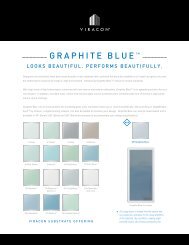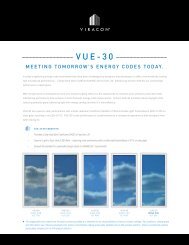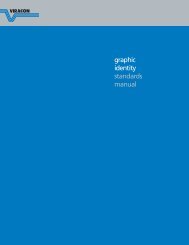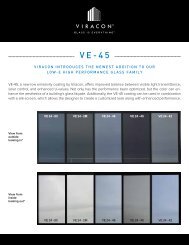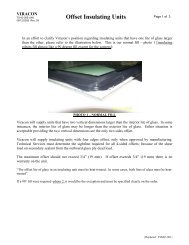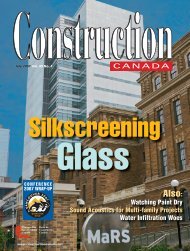You also want an ePaper? Increase the reach of your titles
YUMPU automatically turns print PDFs into web optimized ePapers that Google loves.
800 Park DriveOwatonna, MN 55060800.533.2080viracon.com<strong>Glass</strong> <strong>Cleaning</strong> and Maintenance RecommendationsAll of <strong>Viracon</strong>'s architectural glass products require routine cleaning to prevent the build-up ofpotentially harmful mineral deposits and airborne contaminants.During the construction period, the glass may become more heavily soiled then at any othertime. Special care should be taken at the initial cleaning to make certain the glass surface willnot be damaged because of heavy surface contamination. The first time the glass is cleanedafter building construction or at any time during the construction phase, the glass surface shouldfirst be rinsed with clean water. This is done to remove any surface contamination that may bepresent which could potentially scratch the glass during the cleaning process. The glass shouldbe cleaned with a soft, clean, grit-free cloth and a mild, non-abrasive, non-alkaline cleaningsolution. The glass should be rinsed immediately with clean water and excess water should beremoved from glass surfaces with a squeegee.For routine cleaning, use a commercial window washing solution or mild soap and water.Uniformly spray or apply the cleaning solution with a soft, grit-free, cloth sponge or pad andrinse thoroughly. The glass surface should then be wiped dry with a clean grit-free cloth orsqueegeed dry. Care should be taken to ensure that metal does not come in contact with theglass surface and that no abrasive particles are trapped between the glass and cleansingmaterials. Razor blades, scrapers, putty knives and metal parts of glazing tools can scratchglass surfaces and should not be used to clean glass.Additional Considerations.In all cases when cleaning glass, extreme care should be taken to ensure that noabrasive particles are trapped between the glass and cleaning materials.Construction Sites: Debris or grit that accumulates on glass can be damaging if not handledcorrectly. <strong>Cleaning</strong> should begin by soaking the surfaces with a water and soap solution. Flushas much of the grit as possible with a spray of clean water. Reapply the window washingsolution and wash with a squeegee or grit free rag. Uniformly spray or apply the cleaningsolution with a soft grit free cloth sponge or pad and rinse thoroughly. The glass surface shouldthen be wiped dry with a clean grit free cloth or squeegeed dry.Concrete or motar slurry that runs down (or is splashed on) glass can be especially damagingand should be washed off as soon as possible. It is extremely alkaline and will eventually etchthe glass surface. Begin by soaking the surfaces with a water and soap solution to loosenmortar. Next, flush as much of the grit as possible with a spray of clean water. Reapply thewindow washing solution and use a squeegee or grit-free cloth. It is strongly recommended thatwindow washers clean a small area or one window, then stop and examine the surface for anydamage to the glass.2.3-7989-MGU 08/12/2014 Page 1 of 2
<strong>Viracon</strong>Page 2 of 2Cup Marks: Vacuum cups are utilized to move and install large glass lites. The cups are madeof silicone or rubber and can transfer small amounts of these materials onto the glass surface.The appearance of cup marks can be exacerbated by accumulation of dust and debris from theconstruction process. <strong>Glass</strong> protection and/or routine cleaning during the construction processwill help to minimize this effect.Over the course of time, cup marks normally fade away due to repeated cleanings andexposure to the environment.Manually removing cup marks is challenging. We recommend rubbing the affected area withnon-abrasive powder cleansers.RoomSide Low-E: No special cleaning requirements are necessary to clean <strong>Viracon</strong>’sRoomSide Low-E coated glass.Silicone: Excess silicone on the glass face can be removed. If the glass is dirty, flush off thegrit particulates with a spray of clean water. Remove as much of the silicone as possible fromthe glass without damaging the surface. A thin film of silicone may remain on the face of theglass. Once the silicone is thin enough, soak it with an isopropyl alcohol solution and use 4ought steel wool (0000) to remove the remainder.Suggested Cleaners: We recommend mild, non-abrasive, non-alkaline cleaning solutions ornon-abrasive powder cleansers. The following have been used successfully in the past: Basic H® Classic Formula 409® <strong>Glass</strong> & Surface Cleaner Sparkle <strong>Glass</strong> Cleaner Windex® Original <strong>Glass</strong> Cleaner







